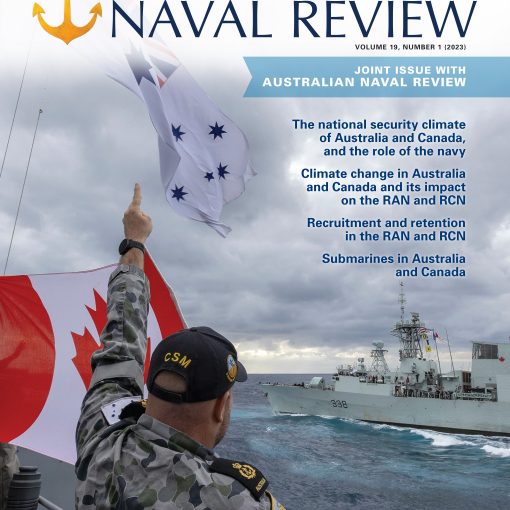Peter Haydon has seized on the need for a significant government response to the current economic crisis to make a powerful case for initiating a stabilized ‘made-in-Canada’ programme for the on-going construction of new naval vessels.
His proposal is impressively persuasive, and there is no question that the ‘stop-go’ pattern of production typical of Canadian naval procurement in the past has been grossly inefficient on a variety of counts. Clearly the best way to develop and maintain the necessary construction and outfitting expertise at all levels – from design to launch – is to have new keels laid at regular intervals so that the pertinent labour forces employed by both the yards and their external suppliers can be sustained and refreshed on a continuous basis over the long haul.
To the extent, moreover, that procurement enterprises of this sort have a secondary purpose in promoting the economic prosperity of particular communities (Saint John, for example, or Halifax, or Levis, or a comparable community on the Pacific coast), this objective would be achieved much more effectively were the building process to be freed from the disruptions that inevitably result from prolonged shut-downs. In practice, as we all know, the latter have materialized almost routinely in the wake of periodic bursts of frenetic activity. Governments have hurriedly sought to replace entire classes of obsolete and rusted-out vessels in short time-frames, only to abandon production entirely once the project has been completed. Presumably the assumption on each occasion has been that the underlying problem has been dealt with for another generation. It seems obvious that it would be much better for all concerned – and not only for Maritime Command itself – if the building process were sustained on a continuing basis and at a steady pace, even if budget constraints meant that the rate of production (by volume) under such a system would have to be somewhat reduced. Among other things, a programme of this sort would mean that at least some of the navy’s vessels would always be up-to-date and state-of-the-art.
My own view is that a proposal of this sort might be politically more marketable, as well as nationally more useful, if it were designed not merely as a means of continuously maintaining and refurbishing Maritime Command, but of doing the same for other categories of government vessel (many of them security-relevant), as well. Currently, for example, we are in desperate need, as the government itself has recognized, of a new fleet of substantial icebreakers for use in the melting Arctic. Our oceanographic research vessels are also nearing the end of their useful lives, as are many of our ferries and some of our larger Coast Guard platforms. Obviously vessels of this kind are in many respects less demanding from the technological point of view than are naval vessels equipped with modern defences and weaponry, esoteric communications and guidance systems, and the like, but there is no reason why the construction of more conventional platforms could not be interspersed with the laying of keels for new warships as a way of keeping the production line active. Moreover, at least some of them (notably the icebreakers and other Coast Guard ships) have security-related functions that could be mobilized to protect their construction at home from potential challenges posed under WTO trade rules by competing builders abroad.
But this is an implementation detail. At the level of principle, the kind of programme Peter Haydon has in mind is clearly well-conceived, and particularly so at a time when the threats to Canada’s maritime interests, not least of all in its adjacent waters, are intensifying.
Having said that, it may not be wise to link the timeliness of the proposal too closely to the current economic crisis. The temptation to do so arises from the widely discussed and vigorously debated need for a substantial injection of new purchasing power into the economy as part of the government’s response to the downturn in the global business cycle – a downturn originating in the ‘paper’ economy, but now being painfully felt in the ‘real’ economy, too. Central bankers around the world, including our own, have already taken major monetary policy initiatives to deal with the problem, and their efforts have been augmented by direct injections of government capital into selected enterprises at the ‘commanding heights’ – including most notably some of the major financial institutions and the automotive industry.
No one knows whether these efforts will be sufficient to do the job, but there is a strong feeling in many quarters that other fiscal primings-of-the-pump are also required. In Canada, all the political parties seem to share this view. Even the ruling Conservatives – strongly opposed in principle to deficit spending and to ‘big’ government generally – have accepted it. They may have done so reluctantly, and for reasons that may be rooted as much in political necessity as in a genuine conviction about how best to respond to an unusually extreme gyration in the business cycle. But the fact remains that they have been in active consultation with provincial and municipal governments, as well as with other authorities (professional economists prominently among them), in attempting to determine precisely where public spending should be directed in order to generate the quickest and most effective result.
The initial emphasis was focussed on infrastructure – roads, hospitals, universities, mass-transit systems, schools and the like. The big problem was to identify targets that were, in effect, “ready to go” – targets, that is, that did not require a lot of lead-time to get off the ground.
We are still in the early days, but the evidence now seems to suggest that such targets have not been easy to find, and even in cases where quick ‘start-ups’ appear feasible in principle, other barriers may be in place that prevent them from being useful in practice. In Nova Scotia, for example, there are indications that there are sufficient construction projects already on the books to keep the local construction industry fully occupied for well over a year. Given the shortage of skilled labour in the region, it’s not clear that a battery of new ‘public works’ initiatives would be feasible in the short run, or that it would be helpful to try to make them so.
It may be partly these considerations that have led the Minister of Finance to put so much emphasis on tax reduction as his primary vehicle for enhancing the purchasing power of consumers and thereby stimulating the economy at large. Economists and other observers may be quite right in saying that this may not help very much, since consumers, under the current gloomy circumstances, are more likely to use the windfall to pay off debt or build up savings than to purchase new goods and services. But from the government’s point of view, tax reduction may still seem to be a far more efficient way of injecting a balanced fiscal stimulus into the economy as a whole than for the government to concentrate on sectors that are more directly responsive to spin-offs from public works.
Such an argument might be regarded by its critics as little more than a convenient policy rationale for a governing party that is ideologically wedded to tax reduction anyway. But there may be evidence of the genuine importance of the underlying difficulty in the fact that Mr. Ignatieff, now the leader of the Liberals, placed a similar emphasis on tax reduction in his comments in Halifax at the start of his cross-country tour. In the end, therefore, the differences between the two largest parties may bear more on the technicalities of how the tax relief is to be distributed, and hence to whom, than on the merits in principle of tax reduction as a source of stimulus. The debate in the end will probably be messy. It usually is. In any case we will have to wait until the budget comes down for the most central disagreements to emerge.
But what has all of this to do with shipbuilding?
It relates to shipbuilding simply because shipbuilding is not the sort of enterprise that can be launched as a solution to a (relatively) short-term business cycle problem. The difficulty with the ‘public works’ approach to business-cycle management generally is effectively compounded in the shipyard context by the exceptionally long lead-time required to get construction underway. At the beginning, such an enterprise would employ a few architects and engineers and keep a lot of public servants (both in uniform and out) busily engaged within the bureaucracy. A significant mobilization of labour, however, could flow from their efforts only after a great deal of time-consuming preparatory work had been completed.
This raises another problem in the context of a government run by fiscal conservatives. The Prime Minister has made it clear from the beginning that any public expenditures undertaken specifically to facilitate an economic recovery will have to be short-term undertakings, and not entail long-term spending commitments of the statutory sort. Otherwise a deficit that might be acceptable in a time of economic crisis would continue in a way that would NOT be acceptable – not to Conservatives, at any rate – in any ensuing period of economic boom. It was precisely the ‘stop-go’ potential of (say) highway construction that at first glance made it seem sensible to focus on infrastructure as a potentially promising avenue to pursue. From this general vantage point, the problem with Haydon’s plan is that it would continue to be a drain on the public treasure even after the economy in general had returned to good health.
The conclusion, therefore, is that the Haydon proposal has to stand on its substantive merits (which are hard to deny), and not on the argument that the kind of initiative he would like to see would be useful as an anti-cyclical instrument of economic policy. It might conceivably turn out to be a potential money-saver in the long-run, but only if it is accepted that the ships are really needed, and that genuine economic efficiencies could result from maintaining a continuing production run over the long term, as opposed to building ‘in bursts’ as the preferred way of responding to spasms of acute need.



